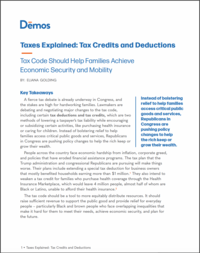Key Takeaways
Instead of bolstering relief to help families access critical public goods and services, Republicans in Congress are pushing policy changes to help the rich keep or grow their wealth.
A fierce tax debate is already underway in Congress, and the stakes are high for hardworking families. Lawmakers are debating and negotiating major changes to the tax code, including certain tax deductions and tax credits, which are two methods of lowering a taxpayer’s tax liability while encouraging or subsidizing certain activities, like purchasing health insurance or caring for children. Instead of bolstering relief to help families access critical public goods and services, Republicans in Congress are pushing policy changes to help the rich keep or grow their wealth.
People across the country face economic hardship from inflation, corporate greed, and policies that have eroded financial assistance programs. The tax plan that the Trump administration and congressional Republicans are pursuing will make things worse. Their plans include extending a special tax deduction for business owners that mostly benefited households earning more than $1 million. They also intend to weaken a tax credit for families who purchase health coverage through the Health Insurance Marketplace, which would leave 4 million people, almost half of whom are Black or Latino, unable to afford their health insurance.
The tax code should be a tool to more equitably distribute resources. It should raise sufficient revenue to support the public good and provide relief for everyday people – particularly Black and brown people who face overlapping inequalities that make it hard for them to meet their needs, achieve economic security, and plan for the future.
Background
During his first administration, President Trump and Republican members of Congress cut taxes for wealthy households and corporations in a major tax reform bill called the “Tax Cuts and Jobs Act” (TCJA). The bill was massively expensive, delivered major tax benefits to the already wealthy, and did little for households with low or moderate incomes. With some elements of that bill set to expire at the end of 2025, President Trump and Republican lawmakers are seizing the opportunity to further reshape the tax code to align with the interests of the wealthy.
In a fair tax code, tax credits and deductions can advance equity by alleviating cost burdens for taxpayers who may struggle to maintain economic security or by helping people access economic opportunities.
In a fair tax code, tax credits and deductions can advance equity by alleviating cost burdens for taxpayers who may struggle to maintain economic security or by helping people access economic opportunities. For example, tax credits like the Earned Income Tax Credit (EITC) and the Child Tax Credit (CTC) provide direct financial relief to households with low or moderate incomes, helping cover essential expenses, including child care, health care, housing, and other necessities. While it is still unclear exactly what tax policy changes Congress will pursue, there are a few credits and deductions that will be prominent in this year’s debate.
Download the full PDF
What are tax deductions?
Tax deductions lower a person’s tax liability because less of their income is subject to tax.
Tax rules allow an individual to deduct a certain amount of income that is not subject to being taxed based on many factors like income levels, family size, number of children, assets, charitable giving, state and local taxes paid, and other qualifying expenses. These tax deductions reduce a person’s taxable income before the tax rate is applied. Tax deductions lower a person’s tax liability because less of their income is subject to tax. When filing federal taxes, a person can choose between two deduction options:
- Standard deduction: If a taxpayer takes the standard deduction, they reduce their taxable income by a flat amount. In 2025, an individual can deduct $15,000 from their income, and a married couple filing their taxes together can deduct $30,000 from their household income.
- Itemized deductions: Itemizing deductions allows taxpayers to list out and deduct certain qualifying expenses from their taxable income. These qualifying expenses include the amount the taxpayer paid in state and local taxes (up to $10,000), charitable contributions, mortgage interest, and others.
Taxpayers itemize only when their qualifying expenses exceed the standard deduction, which occurs more frequently among higher-income households. Black and Hispanic families benefit less from itemized deductions than white families because, on average, those families have lower incomes and are therefore less likely to itemize their deductions. In 2022, 38 percent of households earning more than $200,000 itemized their deductions, while only 7 percent of those making under $200,000 itemized.
What are tax credits?
A tax credit directly reduces a person’s actual tax liability, or tax bill. Unlike deductions (which reduce income before calculating tax), credits directly subtract from the amount of tax you owe after all calculations are complete. There are two types of tax credits:
- Nonrefundable credits: A taxpayer can use a nonrefundable credit to reduce their tax bill down to zero. However, if the tax credit is larger than the amount of taxes owed, the taxpayer will not receive the full credit amount. For example, if a family qualifies for a nonrefundable $2,000 tax credit but their tax liability is only $1,800, they will not receive the remaining $200 of value.
- Refundable credits: When a credit is refundable, it can reduce a taxpayer’s tax liability below zero, which will result in a tax refund. For example, if a family qualifies for a refundable $2,000 tax credit but their tax liability is $1,800, they will receive $200 as a tax refund.
Read more about tax credit and reduction policy, including their impact on equity and what Congress can do to help families achieve economic security and mobility

